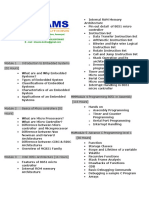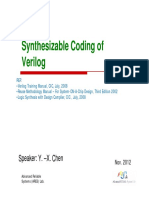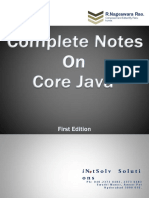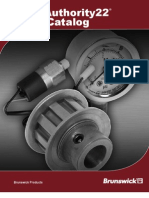SEI CERT Oracle Coding Standard For Java: Front Matter Front Matter
Uploaded by
Nguyễn MinhSEI CERT Oracle Coding Standard For Java: Front Matter Front Matter
Uploaded by
Nguyễn MinhSEI CERT Oracle Coding Standard for Java
The Java rules and recommendations in this wiki are a work in progress and reflect the current thinking of the secure coding community. Because this
is a development website, many pages are incomplete or contain errors. As rules and recommendations mature, they are published in report or book
form as official releases. These releases are issued as dictated by the needs and interests of the secure software development community.
Create a sign-in account if you want to comment on existing content. If you wish to be more involved and directly edit content on the site, you still need
an account, but you'll also need to request edit privileges.
Front Matter Front Matter Secure Java Coding Books
Rule. Preface Content by label There are two books available that cover
Java: one for rules and the other for
There is no content with the specified labels guidelines.
Rules The CERT Oracle
Secure Coding
Rule 00. Input Validation and Data Recommendations Standard for Java
Sanitization (IDS) provides rules for Java
Rule 01. Declarations and Rec. 00. Input Validation and Data Platform Standard
Initialization (DCL) Sanitization (IDS) Edition 6 and Java SE 7.
Rule 02. Expressions (EXP) Rec. 01. Declarations and
Rule 03. Numeric Types and Initialization (DCL)
Operations (NUM) Rec. 02. Expressions (EXP)
Rule 04. Characters and Strings Rec. 03. Numeric Types and
(STR) Operations (NUM)
Java Coding
Rule 05. Object Orientation (OBJ) Rec. 04. Characters and Strings
Guidelines: 75
Rule 06. Methods (MET) (STR)
Recommendations for
Rule 07. Exceptional Behavior (ERR) Rec. 05. Object Orientation (OBJ)
Reliable and Secure
Rule 08. Visibility and Atomicity (VNA) Rec. 06. Methods (MET)
Programs provides
Rule 09. Locking (LCK) Rec. 07. Exceptional Behavior (ERR)
guidelines,
Rule 10. Thread APIs (THI) Rec. 13. Input Output (FIO)
recommendations, and
Rule 11. Thread Pools (TPS) Rec. 15. Platform Security (SEC)
examples to enable the
Rule 12. Thread-Safety Rec. 18. Concurrency (CON)
creation of reliable,
Miscellaneous (TSM) Rec. 49. Miscellaneous (MSC)
robust, fast,
Rule 13. Input Output (FIO) maintainable, and secure code.
Rule 14. Serialization (SER)
Rule 15. Platform Security (SEC)
Rule 16. Runtime Environment (ENV)
Rule 17. Java Native Interface (JNI) Rec. AA. References Source Code Analysis Laboratory
Rule 49. Miscellaneous (MSC) Rec. BB. Definitions
Rule 50. Android (DRD) Rule or Rec. CC. Analyzers (SCALe)
Rule or Rec. DD. Related Guidelines
Rule or Rec. EE. Risk Assessments SCALe offers conformance testing of
Java language software systems against
the CERT Oracle Secure Coding Standard
Rule AA. References for Java.
Rule BB. Glossary
Rule or Rec. CC. Analyzers
Rule or Rec. DD. Related Guidelines
Rule or Rec. EE. Risk Assessments Contact Us
Contact us if you
have questions about the Secure
Coding wiki
have recommendations
for standards in development
want to request privileges to
participate in standards
development
Thank You!
We acknowledge the contributions of the
following folks , and we look forward to
seeing your name here as well.
Rules vs. Recomendations
This coding standard consists of rules and recommendations, collectively referred to as guidelines. Rules
are meant to provide normative requirements for code, whereas recommendations are meant to provide
guidance that, when followed, should improve the safety, reliability, and security of software systems. Lea
rn more about the differences.
Linking to Our Pages
Link to guidelines using the Tiny Link under ToolsLink to this Page... (This URL will not change if the
name of the guideline changes.)
Information for Editors
To eliminate a section from the lists above, label it section and void.
To have a section listed as a recommendation, label it section and recommendation.
To have a section listed as a rule, label it section and rule.
You might also like
- Mitigating Problems With OoO Commit (1)No ratings yetMitigating Problems With OoO Commit (1)44 pages
- Paper Content 80% (Post Relate) 20% (General Knowledge) : Power SectorNo ratings yetPaper Content 80% (Post Relate) 20% (General Knowledge) : Power Sector7 pages
- Java Platform Standard Edition 8 Documentation: What's NewNo ratings yetJava Platform Standard Edition 8 Documentation: What's New2 pages
- Full-Stack-React-JS-Java-Spring-Boot-Training-SyllabusNo ratings yetFull-Stack-React-JS-Java-Spring-Boot-Training-Syllabus19 pages
- Java J2EE SpringBoot Interview Study PlanNo ratings yetJava J2EE SpringBoot Interview Study Plan2 pages
- DIAC #01: Chapter/Topic Description Sr. No. Introduction of TechnologyNo ratings yetDIAC #01: Chapter/Topic Description Sr. No. Introduction of Technology5 pages
- Chainge CertiK+Security+Assessment+for+ChaingeNo ratings yetChainge CertiK+Security+Assessment+for+Chainge12 pages
- Fpga Bases VLSI Design and Implementation: Course OverviewNo ratings yetFpga Bases VLSI Design and Implementation: Course Overview4 pages
- Java Platform Standard Edition 8 DocumentationNo ratings yetJava Platform Standard Edition 8 Documentation1 page
- Core Java Programming Introduction of JavaNo ratings yetCore Java Programming Introduction of Java9 pages
- (Ebook-Pdf) - Corba Programming UnleashedNo ratings yet(Ebook-Pdf) - Corba Programming Unleashed610 pages
- What Is The Security Content Automation Protocol?No ratings yetWhat Is The Security Content Automation Protocol?7 pages
- Mastering Java: A Comprehensive Guide to Programming Excellence CategoryFrom EverandMastering Java: A Comprehensive Guide to Programming Excellence CategoryNo ratings yet
- Learnenglish Professionals: Listen To A Business School Lecturer Speaking About Risk ManagementNo ratings yetLearnenglish Professionals: Listen To A Business School Lecturer Speaking About Risk Management2 pages
- Spiritual Definition of Abundance - Google SearchNo ratings yetSpiritual Definition of Abundance - Google Search1 page
- Florida Supreme Court Order SC09-1910 Statewide Grand Jury No.19No ratings yetFlorida Supreme Court Order SC09-1910 Statewide Grand Jury No.194 pages
- Investigatory Project ON Diabetes Mellitus: Name: Sagnik KulaviNo ratings yetInvestigatory Project ON Diabetes Mellitus: Name: Sagnik Kulavi22 pages
- Regions Beyond Missions These-Thirty-Years - GuinnessNo ratings yetRegions Beyond Missions These-Thirty-Years - Guinness109 pages
- The Role of Education in Promoting Environmental SustainabilityNo ratings yetThe Role of Education in Promoting Environmental Sustainability1 page
- Chapter 7: Learning Curve Individual Online StudyNo ratings yetChapter 7: Learning Curve Individual Online Study5 pages
- Flexi Ul 1007 SC / Flexi Ul 1015 SC: Flexible Single-Core CableNo ratings yetFlexi Ul 1007 SC / Flexi Ul 1015 SC: Flexible Single-Core Cable2 pages
































































































